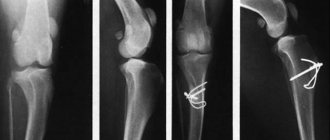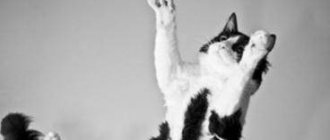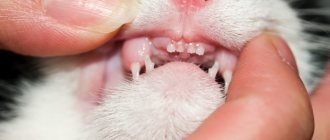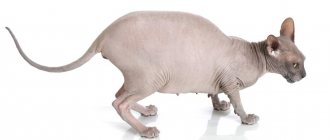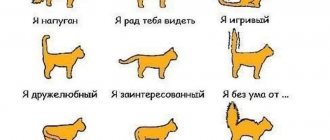The structure of the bones of the limb
The anatomy of the hind and front legs is very different, so they must be considered separately.
The structure of the forelimbs
The scapula is a bone in the form of an elongated triangular plate that attaches the forelimbs to the body with the help of muscles. The wide base points upward. The narrow part of the scapula is directed downward, there is a glenoid cavity on it, into which the humerus is attached through tendons.
An important element is the spine of the scapula - a narrow but steep elevation that runs from top to bottom along the entire length of the scapula. The muscles that are responsible for the movements of the forelimb are attached to it.
The humerus is tubular and is one of the most massive and strong in the skeleton. It has two ends (epiphysis):
- the upper head is rounded, corresponds to the multiaxial shoulder-scapula joint, next to it is the large lateral tubercle - the place of attachment of powerful muscles;
- the lower head is in the form of two tubercles, which form a depression similar to a saddle.
The basis of the forearm is the ulna and radius . On the ulna you can find a large olecranon process - the place of attachment of the powerful extensors of the elbow joint. And also a deep crescent-shaped fossa into which the lower head of the humerus enters.
The radius is thinner; together with the ulna, it allows the forelimb to rotate slightly around the longitudinal axis. This is necessary due to the fact that the elbow joint is a uniaxial block joint; its structure allows for movements with a wide amplitude, but does not provide the opportunity.
The wrist in dogs is represented by a number of separate asymmetrical bones. Five fingers are attached to these bones, four large ones form the metacarpus itself, and the fifth short finger is rudimentary, located behind the metacarpus in dogs. The bones that attach to the wrist are called metacarpals, and the bones that form the fingers are called phalanges:
- the uppermost phalanx is the fetlock;
- middle second – coronal;
- the lower third is claw-shaped (the claw itself).
The structure of the hind limbs
The belt of the hind limbs is the pelvis - a complex symmetrical structure. Each half is called an innominate bone , which in turn consists of three fused bones:
- ileal;
- ischial;
- pubic
The ilium is the largest bone, located above and in front, it rests on the pelvis and connects to it through the flat sacroiliac joint . The ischium in dogs is short and located at the back. Each half of the pelvis fuses below with the adjacent half through the pubic bone. At the site of fusion of the pubic, ilium and ischium bones there is a deep articular cavity into which the head of the femur enters.
femur is one of the strongest bones in the body. At its upper end there is a spherical head, which fits into the cup-shaped articular cavity of the pelvis. This joint gives the greatest freedom of movement; for example, male dogs can move their leg far to the side when urinating.
The lower end of the femur is flatter, it is formed from two semicircular tubercles, between which there is a saddle-shaped fossa. It, together with the heads of the tibia and fibula, forms the trochlear joint. The joint also contains the kneecap, a bean-shaped bone with a base and an apex. The patella prevents the knee joint from bending forward.
The fibula in dogs is significantly smaller than the tibia. The latter is especially massive at the upper end, and at this end it bends quite strongly. The fibula at its lower end often fuses with the tibia. The structure of the metatarsus and tarsus of the hind limb is the same as that of the front paw.
Types of fractures
According to the etiological factor, all fractures can be divided into two large groups: traumatic and pathological.
Traumatic fractures . Their causes are various types of mechanical influence. For example, running a car over a pet's leg, jumping from too high a height, fighting with a larger dog.
Pathological fracture . With him, the situation is much more dangerous, since the real cause is a violation of bone strength, that is, another disease. Often it becomes osteosarcoma or impaired absorption of calcium and phosphorus, as well as old age in combination with improper feeding.
Signs of a fracture
Symptoms vary depending on the severity of the fracture:
- A fracture is when the integrity of the cross section of the bone is only partially broken. This type of fracture can easily be mistaken for a bruise, as the pet remains active but moves with caution. An important difference is that when a bruise occurs, soft tissues are damaged and swelling can be detected. When a bone is cracked, the surrounding tissue is not damaged.
Important! A crack is a dangerous injury, as it can turn into a real fracture at any moment.
- An impacted fracture is when bone fragments fit into each other. This happens if the mechanical impact was directed not across the bone, but along it. For example, a fracture of the front paw when jumping from a great height. The dog's lameness becomes very severe, while the surrounding tissues are not damaged, there is no swelling, but you can find that the damaged limb is slightly shorter than the healthy one.
Remember! If you do not treat your pet, the fracture may become more complicated and become multiple, otherwise the bones will not heal properly, which is even worse, as the dog will become disabled.
- A closed fracture without displacement is when the parts of the bone are in a natural position relative to each other, the surrounding tissues are slightly damaged. The animal refuses to stand on its paw and does not allow anyone to touch the fracture site (behaves aggressively). You may notice redness or swelling at the site of injury.
- A closed fracture with displacement is when parts of the bone are displaced relative to each other and their natural position. In this case, the surrounding tissues are more damaged. The pain reaction is strong, the dog whines and licks the fracture site. Large swelling is visible under the skin, and hematomas are often found. There is almost always asymmetry of the limbs. Sometimes you can find a bulge - a piece of bone resting on the “other side” of the skin.
Important! This is the most dangerous type of injury, since the owners are in no hurry to see a doctor (visible signs do not cause concern), while the dog has severe internal hemorrhage.
- An open paw fracture is when the bones stick out. The most frightening of all fractures, since the very fact of a bone protruding from the leg can plunge both the pet and the owner into shock. True, in muscular breeds the fragment is not always visible, but the wound and bleeding are always detected. This is also a dangerous type of fracture, but only if the blood vessels are damaged, in which case the blood must be stopped before taking the pet to the hospital.
- Finger fractures . Injury often occurs if a large object is dropped on the pet's leg or a car runs over it (dogs love to run after them). As a result of such an impact, not just one finger is often broken, but several or all at once. Typically, such fractures are closed and displaced, but there is little swelling. It is very difficult to diagnose such a fracture without x-rays.
Remember! If the dog is limping and you cannot identify a broken leg, you should still go to the veterinary clinic immediately.
Methods of movement rehabilitation
If in the first stages after a fracture it is important to keep the damaged bones in a state of minimal load or complete rest, then as their fusion occurs, a gradual process of development of the injured limb, joint and other organ begins. Depending on the complexity of the initial diagnosis and the patient’s condition, restoration of motor activity occurs at different times, which can only be indicated by the attending physician. But in most cases, the first careful walks with your pet can be carried out 2-3 weeks after fixing the bones and then methodically increase the load. In this case, it is important to carefully monitor the behavior of the animal, avoiding overwork of the affected organ.
Exercises
In addition to the gradual return of physical activity, for the proper restoration of damaged bones and tissues, the animal must perform special exercises, the main goal of which is to strengthen atrophied muscles, build muscle mass and restore the lost sense of one’s own body. This special muscular sense has the scientific name "kinesthesia" (from the ancient Greek words "κοινός", general, and "αἴσθησῐς", feeling), as well as "proprioception", from the Latin words "proprius", own, "receptor", sensitivity, and "capio", to perceive).
Specific exercises depend on the location of the fracture, but the following types of loads are usually used as general recommendations:
- Walking up an incline.
- Cavalletti (stepping over obstacles) - helps synchronize muscles and increase their mass.
- Consistent execution of the commands “sit” and “stand” trains the hind limbs.
- Walking on non-standard surfaces (sand, snow, tall grass, water, rough terrain, coniferous forest floor, gravel, etc.) stimulates the rapid restructuring of the muscles of the limbs.
- Balancing. Special simulators are used; if they are not available, you can ask the pet to put its front paws on a board located at the level of its chest, leaving its hind limbs on the floor, and then begin to swing the board, provoking the dog to maintain balance. Another variation of the same exercise is to walk or hold in a standing position on a narrow board slightly elevated above ground level.
- Jumping onto a dense horizontal surface, the height of which gradually rises.
- Pulling exercises with increasing weight and duration of load.
- Walking and slow running (trot).
- Agility - exercises for agility, speed, agility (jogging, sprinting, tug of war, jumping, zigzags, etc.).
- Dynamic exercises - pursuit, active search, etc.
It is important to start training with the simplest exercises. For example, during the first week after the fixing bandage is removed from the animal (2-3 months may have passed since the fracture), the dog should simply walk at a slow pace. Next, the duration of the walk increases by 10–15 minutes. From the third week of classes, you can gradually add movements at an accelerated pace and other exercises as their complexity increases. In addition, all strength and endurance tasks are carried out only after a warm-up step to ensure proper warm-up of the muscles. You should finish your workout in the same way.
The intensity and intensity of exercises should be selected individually, based on the general condition of the animal: what is normal for a young hunting dog is absolutely not suitable as a compensatory load for an ornamental pet that has been lying on the couch all its life and can lead to premature wear and tear of the body.
Exercises in the water
Most doctors agree that water exercises during the recovery period after fractures and other injuries of the musculoskeletal system are much more productive than walking, running and strength exercises. The main reason for this phenomenon is that water provides an even load on all muscle groups.
In addition, overcoming the resistance of the water layer during exercise in the pool guarantees:
- training those muscles of the back and limbs that are almost never used during exercise on land;
- avoiding overstrain of the joints with a high amplitude of their development;
- balanced cardio load;
- strengthening blood vessels;
- improved blood circulation;
- formation of the correct respiratory rhythm, increasing the elasticity of the lungs;
- development of stress resistance, endurance and flexibility;
- getting rid of excess weight (very dangerous during the rehabilitation period);
- a good mood, which is extremely important for a recovering pet.
First aid for a broken paw
It is only necessary for open fractures. The main task is to stop the bleeding. Usually you don’t have a tourniquet at hand (but if you do, use it), so you’ll have to use improvised materials. To do this, you need to wrap the area above the wound with a piece of cloth, a scarf, or gauze pads, and then bandage it tightly with a bandage or a simple rope.
Please note two important points:
- To stop the bleeding, you need to bandage not the wound itself, but the place above it.
- You cannot apply a tourniquet directly to the skin, you can damage it; be sure to place a piece of cloth, a bandage, or a napkin.
It is also recommended to fix the limb, but here the owners forget that “fixing” does not mean setting the fragments.
Remember! Never try to set a broken bone, it's incredibly painful.
In addition, you can damage the limb even more, even to the point of rupture of blood vessels. Just secure it by tying it to a stick, plywood, or another limb. When transporting your pet, make sure that the injured limb is on top and not loaded.
If you are not sure what first aid should be, then do nothing, but simply take your pet to the veterinary clinic as quickly as possible.
The prognosis is usually favorable. The bones grow together within a few weeks; if the osteosynthesis was carried out correctly, then there will be no consequences in the form of lameness. Cautious prognosis in the presence of osteosarcoma.
Why is rehabilitation needed?
In addition to the nature of the injury, the duration of rehabilitation and its prognosis are also influenced by many other factors, most notably the size of the animal.
Other criteria that determine the duration of recovery include:
- age;
- presence or absence of excess weight;
- general health (skeleton, muscular system, etc.);
- the experience of the veterinarian who performed the treatment;
- correctly selected and completed rehabilitation course.
This is why caring for a recovering animal is so important.
The process of bone fusion should be constantly monitored by a veterinarian. This is what will allow you to adjust treatment in time and prevent relapses.
In addition, due to the forced immobility in which the animal finds itself in the first days after the fracture, pathological changes that are dangerous to the general health of the animal begin to develop in the body, including:
- rigidity (hardening, loss of pliability) of muscles, sometimes developing into atrophy;
- impaired blood supply to organs and tissues (especially when using a tight cage);
- loss of sensation in the limbs;
- anomalies of the lymphatic system, disruptions of lymphatic drainage, etc.;
- thrombosis;
- swelling of tissues, etc.
Various rehabilitation programs for dogs that have suffered fractures are aimed at preventing all these complications.
Treatment of paw fractures
First, the doctor will provide high-quality anesthesia; without this, the dog will not allow itself to be examined. Next, the limb and pet are examined, an x-ray of the broken paw is prescribed, as well as an ultrasound, x-ray , and other studies if damage to internal organs is suspected. For example, when falling from a great height or being hit by a car, a broken paw in a puppy is almost always combined with an injury to the abdominal cavity or chest.
Need for surgery
When a dog's paw is broken, it is almost impossible to get by with a plaster cast , so in 99% of cases surgery is necessary. Surgery is indicated for several reasons:
- It is almost impossible to force a dog to take care of the leg and the cast. A fracture of the hind leg may still allow this, but not always. Pets try to remove the cast as soon as possible, even if they fail, they can still cause additional injury to themselves.
- Since pets never break their legs through negligence, they are more often open, multiple with various complications. Therefore, an operation is needed to connect all the fragments and sew up the damaged tissue.
- Research has proven that bones heal most quickly and efficiently with careful comparison of fragments and their reliable fixation; early support on the limb has a positive effect. All this is possible only with surgery.
Types of operation
The fusion of bones is called osteosynthesis. There are several types of surgery:
- Elezarov's apparatus . The fragments are fixed using knitting needles on metal rings. This method is applicable for large and medium breeds. The ring is not removable and securely fixes the bones.
- The Kishner apparatus is a structure made of self-tapping rods attached to a metal stay. It is usually used for intra-articular fractures and when it is not possible to install the Elizarov apparatus. Recently, special thinner self-tapping needles and plastic rods have been used, but the basic principle of the Kishner apparatus remains unchanged.
- Internal fixation is used when it is impossible to install any of the devices. In this case, the pins are inserted inside the tubular bone. Later they are not removed, but are left for life. This type of operation is the most complex, and not every surgeon is capable of performing it efficiently.
The doctor decides which type of operation to choose and what to do. The choice depends on the type and characteristics of the fracture, as well as on the experience and preferences of the veterinarian.
Rehabilitation of a dog with a broken paw
Further treatment at home can take place in the absence of postoperative complications (blood clots, surgical infection). Usually, after making sure that everything is in order, the dog is discharged after 6-24 hours. The owner’s task is to provide peace for the pet, and to prevent the dog from gaining weight (due to inactivity), a diet should be prescribed . Special care consists of giving painkillers, calcium supplements, and daily treatment of sutures.
The pet begins to lean on the limb after 3-5 days, and the fracture heals completely within 2-3 weeks, after which time the dog begins to run and play. However, the strength of the bone at this time may be low, so it is recommended to protect the pet from excessive mobility and traumatic situations for another 2-3 weeks. In total, rehabilitation is 4-6 weeks; in the third or fourth week it is advisable to take an x-ray and make sure that the bone is healing correctly.
Main objectives of rehabilitation
Restoring weight-bearing ability as quickly as possible.
Intuitively, both a person and a dog try to take care of an injured limb. This is justified when the injury has just occurred, the fracture is unstable, and loading can worsen the situation. However, even after the fracture has been stabilized, the feeling of the need to protect the limb remains, both for the dog and for the owner. Unfortunately, this is what often prevents a full recovery.
First, osteosynthesis is a procedure aimed at stabilizing the fracture. When properly executed, the design can withstand loads similar to those on a healthy limb. Therefore, there is no need to worry about the spokes or plates breaking.
Secondly, dog rehabilitation is a very wide range of different methods, ranging from the simplest and most gentle. And it must be started in the very first hours after the operation - but this does not mean that the dog that has just recovered from anesthesia will be forced to swim in the pool or balance on a fitball. The rehabilitation doctor draws up a program focused on the patient’s condition immediately after surgery and the speed of his recovery.
Even 2-3 days of lack of rehabilitation in a situation with fractures can be decisive in the matter of recovery. This is especially true for complex fractures, for example, with a softened hip fracture, even in the conditions of a timely and competent operation without an immediate start of rehabilitation, a contracture of the femoral biceps forms on the 2-3rd day. This is an irreversible condition that can be slightly improved, but the dog will no longer be able to fully use this limb. But even for simple fractures, a long period of immobility can lead to irreversible muscle contractures, shortening of ligaments, and, as a result, a deterioration in the quality of life.
On average, restoration of supporting ability (incomplete) should occur by the end of the second week after injury.
Rehabilitation methods can also help with advanced fractures, when contractures have already formed - improve the elasticity of the ligaments, blood circulation in the affected limb, and, as a result, make the dog’s life more comfortable. For fractures that cannot be stabilized with osteosynthesis (for example, greenstick fractures due to secondary hyperparathyroidism, when low-density bones simply do not allow plates or wires to be fixed), careful restriction of mobility is necessary. However, even in this case, there are a number of rehabilitation methods that will prevent secondary degenerative changes.
Pain control.
Recovery from fractures also requires pain control. Pain can be relieved both with medication and with the help of physical therapy methods. Both methods are actively used when drawing up a rehabilitation program. Once the fracture has been stabilized, pain is no longer a factor necessary to prevent injury and must be managed.
Strengthening the muscles of the injured limb
Early restoration of weight-bearing ability does not mean that the dog will immediately walk fully, therefore, to fully restore the function of a broken limb, it is necessary to strengthen the muscles.
Diet for feeding a dog with fractures
When feeding a dog with a fracture, you need to provide its body with a sufficient amount of calcium, protein, vitamins and microelements. If the owner does not have the opportunity (or desire) to bother with preparing a natural diet, it is best to feed the dog with ready-made industrial food for animals with diseases of the musculoskeletal system:
- Hill's series j/d.
- Eukanuba Joint Mobility.
- Royal Canin Mobility series, as well as analogues from other renowned manufacturers.
But the problem is that not everywhere there are high-quality veterinary holistic specialists, and therefore breeders have to deal with “natural” animals.
An approximate diet for feeding a dog with fractures:
- As a source of protein, you can use chicken, rabbit, and lean duck every day.
- If the dog does not suffer from intolerance to dairy products, he is given low-fat cottage cheese (natural, crumbly) 2 times a week. This is a source of calcium.
- Give low-fat sea fish 3 times a week (it is better to boil it lightly, or steam it or scald it with boiling water). This product contains a lot of vitamin D for bones, magnesium and polyunsaturated Omega-3 fatty acids, which help accelerate tissue regeneration.
- The dog can be given egg yolk and/or beef liver 2 times a week. They contain a lot of phosphorus.
Recovery after a fracture
The rehabilitation period for a pet depends on many reasons. An important role in the process of restoring joint mobility belongs to the care of the animal after injury and the recovery period. The owner must pay attention not only to the therapeutic complex of physical exercises, but also to the diet.
The dog should be fed only high-quality industrial food, enriched with protein and mineral ingredients. With a natural type of nutrition, the diet should be supplemented with calcium, magnesium, and vitamin D. For this purpose, on the recommendation of a veterinarian, multivitamin and mineral complexes are included in the diet.
We recommend reading about a broken paw in a dog. You will learn about the causes and types of fractures, diagnosis, emergency care for your pet, and treatment.
And here is more information about massage for dogs.
A bone fracture in an animal is a serious challenge for both the pet and its owner. Strict compliance with the surgeon’s instructions and regular exercises with the animal contribute to the full restoration of the motor function of the damaged part of the body. Not the least role in rehabilitation belongs to a nutritious diet.
